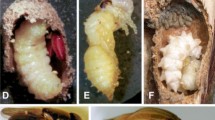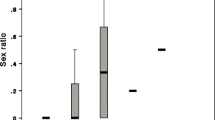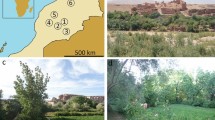Abstract
Social parasitism has evolved at least ten times in the allodapine bees but studies that explore the parasite’s integration and exploitation of host colonies are lacking. Using colony content and dissection data, we examine how Inquilina schwarzi affects the social organisation of its host Exoneura robusta. Our samples include three critical periods in the host life cycle: initial formation of dominance hierarchies in late autumn, commencement of oviposition by host queens in late winter, and development of secondary reproductives in late spring. I. schwarzi preferentially parasitises larger host colonies in autumn, but during autumn and winter, the parasite appears to be socially invisible, living in the nest without disrupting the normal functioning of these colonies. Inquilines begin egg laying much later than their hosts, and by late spring, they have disrupted host reproductive hierarchies, leading to lower skew in ovarian sizes of their host nestmates. Living invisibly within the host nest for the first 6 months and waiting until well after host reproduction has begun before disrupting their social organisation appear to be unique among social insects. Such a change in strategy may be facilitated by the different social systems found in allodapine bees, with the social parasites possibly disrupting the reproductive hierarchies during spring to prevent or reduce the normal dispersal of some host females from their natal nests.



Similar content being viewed by others
References
Bourke AFG, Franks NR (1995) Social evolution in ants. Princeton University Press, Princeton
Bull NJ, Mibus AC, Norimatsu Y, Jarmyn BI, Schwarz MP (1998) Giving your daughters the edge: bequeathing reproductive dominance in a primitively social bee. Proc R Soc Lond B Biol Sci 265:1–5
Cervo R, Turillazzi S (1996) Host nest preference and nest choice in the cuckoo paper wasp Polistes sulcifer (Hymenoptera: Vespidae). J Insect Behav 9:297–306
Cervo R, Stemmer C, Castle W, Queller D, Strassmann JE (2004) Social parasitism of Polistes dominulus by Polistes nimphus (Hymenoptera, Vespidae). Insectes Soc 51:101–108
Dapporto L, Cervo R, Sledge MF, Turillazzi S (2004) Rank integration in dominance hierarchies of host colonies by the paper wasp social parasite Polistes sulcifer. J Insect Physiol 50:217–223
D’Ettorre P, Mondy N, Lenoir A, Errard C (2002) Blending in with the crowd: social parasites integrate into their host colonies using a flexible chemical signature. Proc R Soc Lond B Biol Sci 269:1911–1918
Fisher RM (1984) Dominance by a bumble bee social parasite (Psithyrus citrinus) over workers of its host (Bombus impatiens). Anim Behav 32:303–304
Foitzik S, Fischer B, Heinze J (2003) Arms race between social parasites and their hosts: geographic patterns of manipulation and resistance. Behav Ecol 14:80–88
Hogendoorn K, Schwarz MP (1998) Guarding specialisation in pre-reproductive colonies in the allodapine bee Exoneura bicolor. Ethol Ecol Evol 10:67–77
Hölldobler B, Wilson EO (1990) The ants. Belknap Press of Harvard University Press, Cambridge
Hurst PS, Gray S, Schwarz MP, Tilly JA, Foran AC, Adams M (1997) Increased nest cofounding and high intra-colony relatedness in the bee Exoneura bicolor (Hymenoptera: Apidae): results from an experimental situation. Aust J Ecol 22:419–424
Johnson CA, Topoff H, Vander RK, Lavine B (2005) Do these eggs smell funny to you?: an experimental study of egg discrimination by hosts of the social parasite Polyergus breviceps (Hymenoptera: Formicidae). Behav Ecol Sociobiol 57:245–255
Lenoir A, D’Ettorre P, Errard C (2001) Chemical ecology and social parasitism in ants. Annu Rev Entomol 46:573–599
Lorenzi MC, Filippone F (2000) Opportunistic discrimination of alien eggs by social wasps (Polistes biglumis, Hymenoptera Vespidae): a defense against social parasitism? Behav Ecol Sociobiol 48:402–406
Michener CD (1970) Social parasites among African allodapine bees (Hymenoptera, Anthophoridae, Ceratinini). Zool J Linn Soc 49:199–215
Michener CD (2000) The bees of the world. The John Hopkins University Press, Baltimore
Neumann P, Moritz RFA (2002) The cape honeybee phenomenon: the sympatric evolution of a social parasite in real time? Behav Ecol Sociobiol 52:271–281
Nonacs P, Tobin JE (1992) Selfish larvae: development and the evolution of parasitic behaviour in the hymenoptera. Evolution 46:1605–1621
Passera L, Gilbert M, Aron S (2001) Social parasitism in ants: effects of the inquiline parasite Plagiolepis xexe St. on queen distribution and worker production of its host Plagiolepis pygmaea Latr. Insectes Soc 48:74–79
Queller DC, Zacchi F, Cervo R, Turillazzi S, Henshaw MT, Santorelli LA, Strassmann JE (2000) Unrelated helpers in a social insect. Nature 405:784–787
Reyes SG, Michener CD (1990) Observations on a parasitic allodapine bee and its hosts in Java and Malaysia. Trop Zool 3:139–149
Schmid-Hempel P (1998) Parasites in social insects. Princeton University Press, Princeton
Schwarz MP (1986) Persistent multi-female nests in an Australian allodapine bee, Exoneura bicolor. Insectes Soc 33:258–277
Schwarz MP (1987) Intra-colony relatedness and sociality in the Allodapine bee, Exoneura bicolor. Behav Ecol Sociobiol 21:387–392
Schwarz MP (1988) Local resource enhancement and sex ratios in a primitively social bee. Nature 331:346–348
Schwarz MP (1994) Female biased sex ratios in a facultatively social bee and their implication for social evolution. Evolution 48:1648–1697
Schwarz MP, Scholz O, Jensen G (1987) Ovarian inhibition among nestmates of the allodapine bee Exoneura bicolor. J Aust Entomol Soc 26:355–359
Schwarz MP, Silberbauer LX, Hurst PS (1997) Intrinsic and extrinsic factors associated with social evolution in allodapine bees. In: Choe JC, Crespi BJ (eds) The evolution of social behaviour in insects and arachnids. Princeton University Press, Princeton, pp 333–346
Schwarz MP, Bull NJ, Hogendoorn K (1998) Evolution of sociality in the allodapine bees: a review of sex allocation, ecology and evolution. Insectes Soc 45:349–368
Sudd JH, Franks NR (1987) The behavioural ecology of ants. Chapman and Hall, New York
Sumner S, Hughes WOH, Boomsma JJ (2003) Evidence for differential selection and potential evolution in the worker caste of an inquiline social parasite. Behav Ecol Sociobiol 54:258–277
Tierney SM, Schwarz MP, Adams M (1997) Social behaviour in an Australian allodapine bee Exoneura (Brevineura) xanthoclypeata (Hymenoptera: Apidae). Aust J Zool 45:385–398
Visscher PK (1996) Reproductive conflict in honey bees: a stalemate of worker egg-laying and policing. Behav Ecol Sociobiol 39:137–244
Wilson EO (1971) The insect societies. Belknap Press of Harvard University Press, Cambridge
Acknowledgements
We thank Narelle Joyce, Meg Schwarz and Nathan Smith for help with fieldwork. We also thank Tom Chapman and Jocelyn Smith for comments on previous versions of this paper. This work was supported by an ARC Discovery Grant to M. Schwarz, S. Cooper, B. Crespi and T. Chapman (DPO346322) and complied with the current laws of Australia.
Author information
Authors and Affiliations
Corresponding author
Additional information
Communicated by R.F.A. Moritz
Rights and permissions
About this article
Cite this article
Smith, J.A., Schwarz, M.P. Strategic exploitation in a socially parasitic bee: a benefit in waiting?. Behav Ecol Sociobiol 60, 108–115 (2006). https://doi.org/10.1007/s00265-005-0147-z
Received:
Revised:
Accepted:
Published:
Issue Date:
DOI: https://doi.org/10.1007/s00265-005-0147-z




